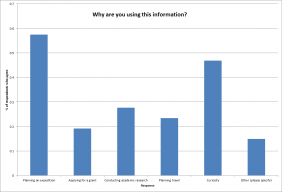RGS-IBG Expedition Database and Report Collection
| Sponsor: | Royal Geographical Society with the Institute of British Geographers |  |
| Sponsor Liaison: | Shane Winser | |
| Student Team: | Peter Craft, Rebecca Lee, William Spurgeon | |
| Abstract: | The goal of this project was to improve the functionality and increase submissions to the Report Collection and Expeditions Database of the Royal Geographical Society (with the Institute of British Geographers) (RGS-IBG). To determine the limitations and possible improvements of the Database and Collection, we conducted an assessment, a survey, and a set of interviews. We then produced a series of guides for volunteers at the Society and a number of recommendations for the future development of the Collection and Database. | |
| Link: | RGS-IBG Expedition Database and Report Collection Final Report | |
Executive Summary
Introduction
Since 1830, the Royal Geographical Society (with the Institute of British Geographers) (RGS-IBG) has curated an impressive collection of photographs, maps, reports and other materials related to expeditions conducted throughout the world. In recent years, the details on these materials have started to become available in the Royal Geographical Society’s databases and collections. This project focused on improving the user experience of the Expeditions Database and the associated Report Collection.
The goal of our project was to work with RGS-IBG to improve the functionality and accessibility of their Expeditions Database, as well as to provide recommendations to encourage contributions to the database. We accomplished this by assessing and improving interactions with the database for all users, by examining the contents of the Expeditions Database and Report Collection, and by developing recommendations to increase the number of submissions to the database.
The RGS-IBG documents and archives a long and proud history of exploration and travel. With much of this information now available to the public, the collection is also adapting to its audience and the times. This project aimed to expand the RGS-IBG’s capacity to meet its own goals of education, and advancing the rich history of the geographical sciences.
Literature Review
To make informed recommendations and to fully understand the scope of the project, we explored the history and role of learned societies in general, the users of Expeditions Database, and the challenges faced by learned societies in the digital age. The RGS-IBG has an open access policy for their database, so we examined some of the controversies behind open access and intellectual property.
The Expeditions Database and Report Collection have several different interfaces and many distinct groups that interact with the database in specific ways. We first classified groups as the RGS-IBG staff (internal users) and the public (external users). From these general categories, we then explored the ways specific groups interacted with the Database and Collection. Internal users are exclusively the staff of the RGS-IBG. They are responsible for maintaining the database, adding new reports, handling copyright and licensing, digitizing records for the Expeditions Database, and accessing the physical reports in the Report Collection for the external users. External users are any individuals that interact with the public web interface of the Expeditions Database or visit the Society to read or request copies of reports in the collection.
We researched some of the major issues faced by learned societies when transitioning to a digital world. We also investigated intellectual property and copyright handling in the UK. Finally, we examined the history of databases themselves and how they can be properly designed. This research gave us a foundation to build upon to achieve our project.
Methodology
We accomplished our goal by completing the following objectives:
- To develop recommendations for improving user experiences
- To develop recommendations for improving the information in the database
- To develop recommendations for additional submissions
To gain a better understanding of the workings of the Expeditions Database and Report Collection before our project, we performed a site assessment. This general overview allowed us to develop the baseline for our analysis of the Report Collection and Expeditions Database. We examined the physical collection, the digital database and the procedures for adding entries to the Expeditions Database and reports to the Report Collection.
There are both internal users and external users interacting with the Expeditions database and Report Collection. Due to the fact that different groups have different needs and concerns, we examined the user experience from several different perspectives. We achieved this examination by utilizing each of the different interfaces used by internal and external users.
To gain a more complete understanding of the needs of the database users and the reasons why they use the database, we collaborated with the Geography Outdoors Office to design a survey to send to the Geography Outdoors mailing list. The questions in the survey were designed to clarify the types of individuals who utilize the database and their motivations for doing so.
To understand the technical capabilities of the staff at the RGS-IBG and how the Expeditions Database and Report Collection were managed, we conducted interviews with internal users. Through these interviews, we explored the history of the Database, the technical aspects of the Database, database maintenance, copyright issues surrounding the database, and how the RGS-IBG staff used the Database or Collection.
Results
During our research, we received data from four areas: the Report Collection, the Expeditions Database, the survey of external users, and the interviews of internal users. As part of the assessment of the Report Collection, we determined the size of the collection, dimensions of the main storeroom, examined boxes and reports, and obtained visual documentation of different parts of the collection. When examining the size of the collection, we found that there are a total of 503 boxes in the Report Collection. There are 309 boxes of final reports, 83 boxes of preliminary reports and brochures, and 111 boxes of duplicate reports. We found that there were seventy boxes that need to be replaced because they were damaged or, most commonly, lacked a handle.
The survey of external users shed light on their motivations for using the database. As Figure 1 shows, the most common reason for people to access the information stored on the Expeditions Database is to assist with the planning stages of a new expedition. We learned that reports from recently returned expeditions prove to be the most helpful for individuals planning their own expedition. The RGS-IBG would be better able to quickly provide these crucial materials to its users if a system existed for quickly and efficiently sorting and inputting materials from the backlog.
Figure 1: Why are you using this information?
During our interviews with the Expeditions Database Manager and the Grants Officer, it became clear that many of the problems with incorrectly entered data came from inexperienced data entry users. Usually these individuals were volunteers who were only there for short periods of time. This has led some fields, even very simple ones, such as “Year”, to have vastly different formats depending on who entered the information.
Our survey of external users provided an insight into the motivations and demographics of those who use and submit to the Expeditions Database. The most important data we obtained from our survey were the results from the two questions asking about the user’s motivation for using the Database. The most common reasons users claimed were 1) a desire to contribute to the Database and 2) a desire to make their reports available to the general public.
Recommendations
We synthesized findings into several recommendations for the RGS-IBG. Our recommendations focus on the development of the Report Collection, improving the quality of data on the database, and making the Expeditions Database more relevant in the digital age. Our recommendations are listed below.
Use and maintain up-to-date user guides
The use of internal user guides could enable the RGS-IBG to ensure that expeditions that are entered into their Database have consistent formatting and information. The guides would also allow work-experience students and interns to become familiar with the workings of the database, without the need for RGS-IBG employees to spend large amounts of time training them. This would allow the interns to begin working more quickly and more efficiently, while also allowing the RGS-IBG staff to focus on more pressing work.
Address the backlog
We recommend a series of steps to best address the backlog.
- Divide the backlog into materials into two groups: those that took place in the past four years and remaining materials. . Because more recent expeditions will have more useful and up to date information, the newest documents should be entered into the collection first.
- Within the first group (expeditions which have taken place in the past 4 years), the newest documents should be entered into the collection first.
- Sort the remaining documents (i.e. older than 4 years) by continent in which the expedition took place. This will create more manageable piles that can be evaluated one at a time by an intern.
Address past data inaccuracies
There is a significant amount of data that has been entered incorrectly or has been entered multiple times, making database searches more difficult. The area with the most pressing need for data clean-up is the “Years” field, where expeditions that took place over multiple years sometimes only correctly list one of the years. In addition, the contacts database contains hundreds of duplicate entries. We recommend that the RGS-IBG invest time into correcting these inconsistencies.
Re-organize and maintain the Report Collection
We recommend that the RGS-IBG reorganize the storeroom and perform maintenance on the boxes and reports. We believe that the space in the storeroom can be better utilized and accessed.
Develop an acquisition policy
The creation of an acquisition policy will allow the RGS-IBG to quickly appraise materials submitted to the Report Collection and then determine whether to incorporate the material into the Collection. An acquisition policy will clearly lay out the qualities of materials to be added to the Collection and will allow the Collection to grow in a more focused and meaningful way.
Digitize and make reports available online
We recommend that the RGS-IBG make the reports in the Report Collection freely available online. Digitizing the reports will make the Collection available to people throughout the world and allow the RGS-IBG to remain a relevant resource in the digital age. Because they are the most useful to users, the newest reports should be digitized first.
Promote the Report Collection and Expeditions Database
Finally, we recommend that the RGS-IBG proactively promote the Expeditions Database and Report Collection. This can include increased visibility for the Database and Collection on the various RGS-IBG social media pages, as well as more links to the web interface through the website.
Conclusion
Our project examined standards for creating new database entries, encouraging more submissions, and assessing the current state of both the Collection and the Database. Moving forward, we recommend the RGS-IBG continue to examine how information can be retroactively corrected on the Database. Further research could conduct a focused assessment of improving and reorganizing the Report Collection, and develop a plan to fully digitize the collections. While time constraints prevented us from conducting comprehensive research into these areas, our work has identified these three issues as potential future projects.



